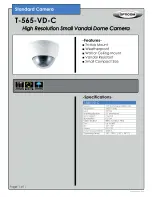
6
Operating instructions
Safety sensor
CSS 8-180
EN
6. Diagnostic functions
6.1 Operating principle of the diagnostic LED's
The safety sensor indicates the operating condition and faults by means
of three-colour LED's located in the lateral surfaces of the sensor.
The green LED indicates that the safety sensor is ready for operation.
The sensor is not actuated. When the safety sensor is actuated by
the CST 180 actuator, the indication switches from green to yellow.
The safety outputs of the safety sensor are enabled. If the actuator is
near the limit of the sensor's switching distance, the yellow LED will
flash. The flashing can be used to prematurely detect variations in
the clearance between the sensor and the actuator (e.g. sagging of a
safety guard). The sensor must be adjusted before the distance to the
actuator increases and before the safety outputs are disabled, thus
stopping the machine. The safety outputs remain enabled. The sensor
can be readjusted before the safety outputs are disabled, thus stopping
the machine. An active fault is indicated by the red flashing LED and
causes the diagnostic output to be disabled. Errors in the coding of the
actuator, at the outputs of the sensor or in the sensor are signalled by
the red LED. After a short analysis of the active fault, signalled by the
red permanent signal, the defined error is indicated by flash pulses. The
safety outputs are enabled in a delayed manner, when the fault is active
for 1 minute.
Flash codes red diagnostic LED
LED indication (red)
Error cause
1 flash pulse
Error output Y1
2 flash pulses
Error output Y2
3 flash pulses
Cross-wire Y1/Y2
4 flash pulses
ambient temperature too high
5 flash pulses
Wrong or defective actuator
Continuous red
Internal error
6.2 Operating principle of the electronic diagnostic output
The short-circuit proof diagnostic output can be used for central
visualisation or control functions, e.g. in a PLC.
The electronic diagnostic output signals faults before the safety outputs
are disabled, thus enabling a controlled shutdown.
The diagnostic output is not a safety-related output.
The diagnostic output can also be used to detect clearance variations
between the sensor and the actuator in the same way as the yellow
LED. An active fault causes the diagnostic output to be disabled. The
safety outputs are disabled after max. 30 minutes if the fault is not
rectified. The signal combination, diagnostic output disabled and safety
channels still enabled, can be used to stop the production process in a
controlled manner.
Table: diagnostic information
Sensor status LED
Diagnostic output Safety outputs
not actuated
green
0 V
0 V
actuated
yellow
24 V
24 V
Actuated in
limit area
flashes
yellow
2 Hz pulsed
24 V
Fault:
1- 5 pulses
flashes
red
10 s delayed
24 V
0 V
1 min delayed
24 V
0 V
Error
red
10 s delayed
24 V
0 V
undelayed
24 V
0 V
Error
Faults which no longer guarantee the functioning of the safety sensor
(internal fault,) will also disable the safety outputs immediately. Any
error that does not immediately affect the safe functioning of the safety
sensor (e.g. the ambient temperature too high, interference potential
at a safety output, cross-wire short) will lead to a delayed shut-down.
In this situation, the diagnostic output will be switched off after approx.
The safety outputs are disabled after max. 1 minute if the fault is not
rectified. This signal combination, diagnostic output disabled and safety
channels still enabled, can be used to stop the production process in a
controlled manner.
After fault rectification, the error message is reset by opening and re-
closing the corresponding safety guard.
The safety outputs will switch, thus enabling the machine. For the
release, the chain of sensors must be permanently actuated.
A cross-wire short at the safety outputs of a sensor chain will
load the sensor from the place where the fault is located up
to the end of the chain. The fault therefore can be signalled
by multiple sensors. Starting from the safety-monitoring
module, the cross-wire short is located before the first sensor
signalling the fault.
7. Disassembly and disposal
7.1 Disassembly
The safety switchgear must be disassembled in a de-energised
condition only.
7.2 Disposal
The safety switchgear must be disposed of in an appropriate manner in
accordance with the national prescriptions and legislations.



























